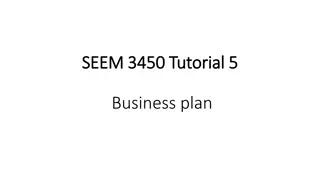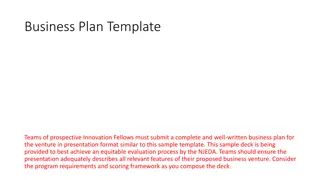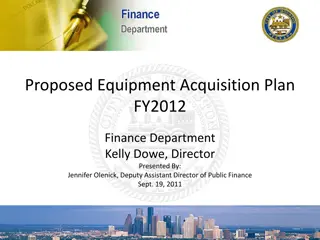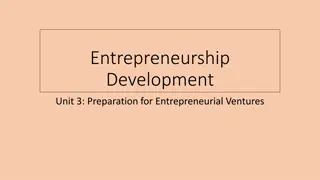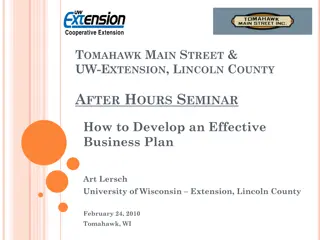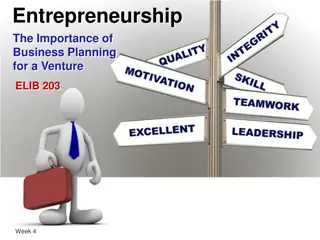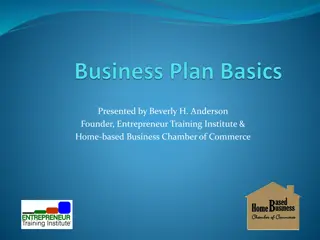Essential Guidelines for Crafting a Successful Business Plan
Craft a concise and accessible business plan, tailored to your audience's understanding. Don't be intimidated by the process; focus on highlighting your business overview, products/services, target market, marketing strategies, and milestones. Remember, simplicity and passion are key to leveraging your plan for growth.
Download Presentation

Please find below an Image/Link to download the presentation.
The content on the website is provided AS IS for your information and personal use only. It may not be sold, licensed, or shared on other websites without obtaining consent from the author.If you encounter any issues during the download, it is possible that the publisher has removed the file from their server.
You are allowed to download the files provided on this website for personal or commercial use, subject to the condition that they are used lawfully. All files are the property of their respective owners.
The content on the website is provided AS IS for your information and personal use only. It may not be sold, licensed, or shared on other websites without obtaining consent from the author.
E N D
Presentation Transcript
Starting a Business LEADERSHIP 9
The Rules of a Business Plan 1. Keep it short and concise. A. you want your business plan to be read. B. your business plan should be accessible, something you continue to use and refine over time.
The Rules of a Business Plan 2. Know your audience A. Should be written in language that your audience will understand. Ex. If your company is developing a complex scientific process, but your prospective investors aren t scientists (and don t understand the language, you need to adapt.
The Rules of a Business Plan 2. Know your audience B. Accommodate your investors, and keep explanations of your product simple and direct, using terms that everyone can understand.
The Rules of a Business Plan 3. Don t be intimidated A. Vast majority of business owners and entrepreneurs aren t business experts. B. If you know your business and are passionate about it, writing a business plan and then leveraging your plan for growth will be easy.
Quick Overview of a Business Plan 1. Executive Summary: an overview of your business and your plans. It comes first in your plan and is ideally only 1-2 pages. 2. Company Overview: The company provides a quick review of the company s legal structure and location, as well as some background on the company s history if you re writing the plan for an existing business.
Quick Overview of a Business Plan 3. Product and Services: What are you actually selling and how are you solving a problem (or need ) for your market? 4. Target Market: Who are you selling to? If there are multiple market segments for your business, this is where you flesh out the details.
Quick Overview of a Business Plan 5. Marketing and Sales Plan: how are you going to reach your target market? What marketing and sales tactics will you be using? 6. Milestones and Metrics: If you ve accomplished some key milestones in the process of building your business, detail them here. This chapter also defines how you measure success.
Quick Overview of a Business Plan 7. Management Team: Investors look for great teams in addition to great ideas. Use this chapter to describe your current team and who you need to hire. 8. Financial Plan: Your business plan isn t complete without a financial forecast. What are the projected costs/sales?
Executive Summary The first chapter of your business plan. It is advised that you write this last once you know the ins and outs of your business. Introduces your company, explains what you do, and lays out what you re looking for from your readers.
Executive Summary Covers the highlights of your detailed plan. Make sure that the summary is clear and concise as possible. 1-2 pages in length
The Critical Components of a Winning Executive Summary One sentence business overview: right under your business name, include a one-sentenceoverview of your business that sums up the essence of what you are doing. This is known as your value proposition.
The Critical Components of a Winning Executive Summary Problem: describe the problem you are solving in the market. Every business is solving a problem for its customers and filling a need in the market. Solution: This is your product or service. How are you addressing the problem you have identified in the market?
The Critical Components of a Winning Executive Summary Target Market: Who is your ideal customer? How many of them are there? It s important here to be specific. Ex.) If you re a shoe company, you aren t targeting everyone just because everyone has feet. You re most likely targeting a specific market segment such as style-conscious men or runners .
The Critical Components of a Winning Executive Summary Competition: How is your target market solving their problem today? Are there alternatives or substitutes in the market? Every business has some form of competition and it s critical to provide an overview in your executive summary.
The Critical Components of a Winning Executive Summary Team: provide a brief overview of your team and a short explanation of why you and your team are the right people to take your idea to market. Investors put an enormous amount of weight on the team more than on the idea because even a great idea needs great execution in order to become a reality.
The Critical Components of a Winning Executive Summary Financial Summary: Highlight the key aspects of your financial plan, ideally with a chart that shows your planned sales, expenses, and profitability. If your business model (i.e., how you make money ) needs additional explanation, this is where you would do it.
The Critical Components of a Winning Executive Summary Funding Requirements: If you are raising money to start or grow a business, you need to include the details of what you need in the executive summary. A short statement indicating how much money you need to get your business off the ground.
The Critical Components of a Winning Executive Summary Milestones and Traction: The last key element of an executive summary that investors will want to see is the progress that you ve made so far and future milestones that you intend to hit.
Company Overview Includes: Mission statement Company legal structure and ownership Brief history of the company, if any Summary of the business
Company Overview Mission Statement: Should be short (one or two sentences at most). Should encompass, at a very high level, what you are trying to do.
Company Overview Mission Statement Example: Here at Palo Alto Software, our mission statement is this: we help people succeed in business. It s simple and encompasses everything we do from the types of products that we build to the kind of marketing that we do.
Legal Structure and Ownership Is it an LLC? A C-Corp? An S-Corp? A sole proprietor? In a partnership? How is the business owned? Does each business partner own an equal part? How is ownership divided?
LLC Combines attributes from both corporations and partnerships. The corporation s protection from personal liability for business debts and the simpler tax structure of partnerships.
C-Corp Business organization structure that provides several non-tax benefits (such as limited liability for the owners).
Limited Liability Limited Liability: the legal protection available to the shareholders of privately and publicly owned corporations under which the financial liability of each shareholder for the company s debts and obligations is limited to the par value of his or her fully paid-up shares.
S-Corp A regular corporation is a regular corporation that lets you enjoy limited liability of a corporate shareholder but pay income taxes on the same basis as a sole proprietor or a partner.
Sole Proprietor A business that is owned by one person (and sometimes his or her spouse) and that isn t registered with the state as a corporation or a limited liability company (LLC)
Partnership A business with more than one owner that has not filed papers with the state to become a corporation or LLC. Two types: General Partnerships Limited Partnerships
Company History A few paragraphs This section can provide new employees with background on the company so that they have better context for the work that they are doing and where the company has come from over the years.
Location Describes your current location and any facilities that the company owns. Important for businesses that require large facilities for manufacturing, warehousing, etc.
Products and Services This is where you will describe in detail the problem that you re solving, your solution, and how your product or service fits into the existing competitive landscape.
Products and Services You ll also use this section of your business plan to demonstrate what sets your solution apart from others, and how you plan to expand your offerings in the future.
Products and Services Defining the problem you are solving for your customers is far and away the most critical element of your business plan and crucial for your business success. If you can t pinpoint a problem that your potential customers have, then you might not have a viable business concept.
Products and Services Your solution is the product or service that you plan on offering to your customers. In this section, you should describe your solution in detail. What is it and how is it offered? How does your solution solve the problem that your customers have?
Competition Most business plans use a competitor matrix to list out competitors and then show how they compare to your business s solution. You can build a simple competitor matrix by listing your competitors down the left side of a grid and then adding columns for each feature. Then use checkmarks to indicate if competitors have a particular feature or not.
Competition The most important thing to illustrate in this section of your business plan is how your solution is different or better than other offerings that a potential customer might consider. Investors will want to know what advantages you have over the competition and how you plan on differentiating yourself.
Competition Competitors may not always come in the form of direct competition , which is when you have a competitor offering a similar solution to your offering.
Competition Often times, you may be dealing with indirect competition , which is when consumers solve their problem with an entirely different kind of solution.
Competition For example, when Henry Ford was first marketing his cars, there was very little direct competition from other car manufacturers. Instead, Ford was competing with other forms of transportation, including horses, bikes, trains, and walking. On the surface, none of these things look like real competition, but these alternative solutions where what people would use to solve their transportation problems at the time.
Sourcing and Fulfillment If your company is buying the products it is selling from other vendors, it s important to include details on where your products are coming from, how do they get delivered to you, and ultimately how you deliver the products to the customer.
Sourcing and Fulfillment If you are sourcing products from manufacturers overseas, investors are going to want to know about your progress working with these suppliers. If your business is going to be delivering products to your customers, you should describe your plans for shipping your products.
Technology : If you are a technology company, it s critical for your business plan to describe your technology and what your technology is. You need to describe how your technology is different and betterthan othersolutions in the market.
Intellectual Property If you have intellectual property that is proprietary to your business and helps your business defend itself against competitors, you should detail that information here.
Future Products and Services It s certainly useful to include a paragraph or two about potential future plans, to show investors where you are headed in the long term, but you don t want your plan to be dominated by long-range plans that may or may not come to fruition.







